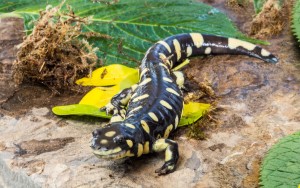California Tiger Salamander
California Tiger Salamander
Ambystoma californiense
California tiger salamanders are endemic to California, meaning they live nowhere else in the world. They are a threatened species in California primarily because of habitat loss. For most of the year, they live underground in ground squirrel and gopher burrows. When the winter rains come, they emerge to breed.
Vernal pools are very important to California tiger salamanders. Vernal pools fill with water from winter rains and snow melt. In springtime, salamanders lay eggs, and the babies (called larvae) will grow in the ponds. By summer, salamanders have emerged from the dried up ponds and moved into underground burrows. When the rains come the next year, salamanders will return to the pools to breed and the cycle starts again.
California tiger salamanders eat insects, worms, and snails. They wait for their food to wander by and then capture it with a snap of their jaws.
Lindsay Wildlife is an official rehabilitation center for local California tiger salamanders. We have two resident tiger salamanders, Manny and Sal, who were unable to be returned back into the wild. You can identify our tiger salamanders by the unique size and pattern of their spots.
Sal came to the Lindsay Wildlife Hospital in 2012 with a broken jaw, broken arm and missing a foot. After rehabilitation and excellent care from our animal keepers, his jaw and arm healed and his foot partially regrew. Limb regrowth has been primarily documented and studied in axolotl salamanders (Ambystoma mexicanum), although there is also anecdotal evidence of it occurring in common tiger salamanders (Ambystoma tigrinum). It has never been officially documented in California tiger salamanders based on our research. Salamander limb regeneration differs from tail autotomy and regrowth in lizards. A lizard can regrow its tail after dropping it in defense, but the new tail is shorter than the original and is supported by a cartilage rod rather than bony vertebrate. Salamanders regenerate everything—skin, tissue, bone, and nerves!
Manny was collected out of the wild as an illegal pet and surrendered to Lindsay Wildlife in 2016. He cannot be returned to the wild due to his time spent in captivity. Placing him back with the wild population could cause spread of captive illnesses. Manny himself is healthy, but could have asymptomatic pathogens that could damage the wild population. Manny is a passionate swimmer; of our three salamanders, he spends the most time in the water and can often be seen paddling slowly across the pond or swimming against the current. His small size belies his appetite, as he is also the most regular eater in our group.

